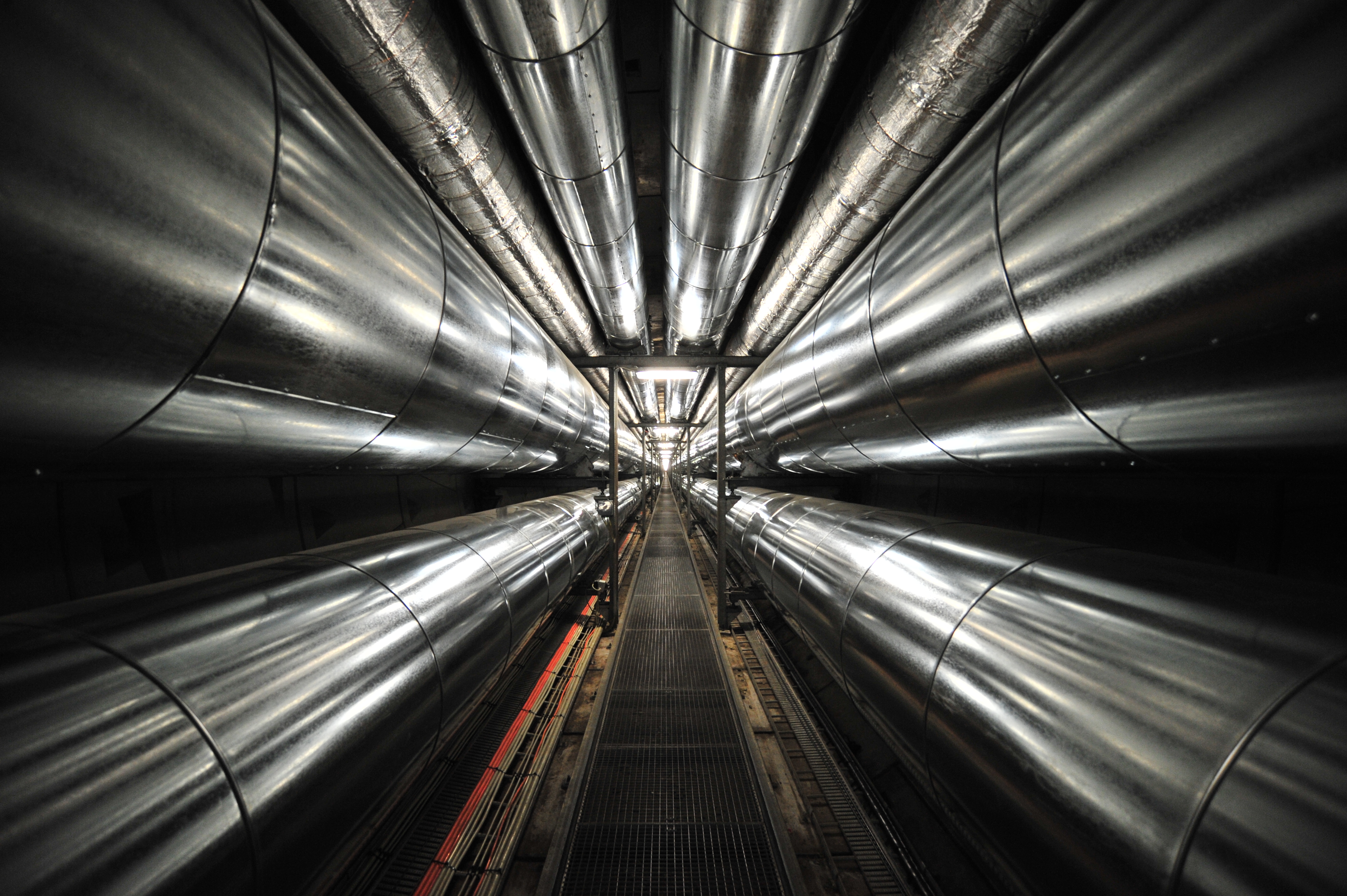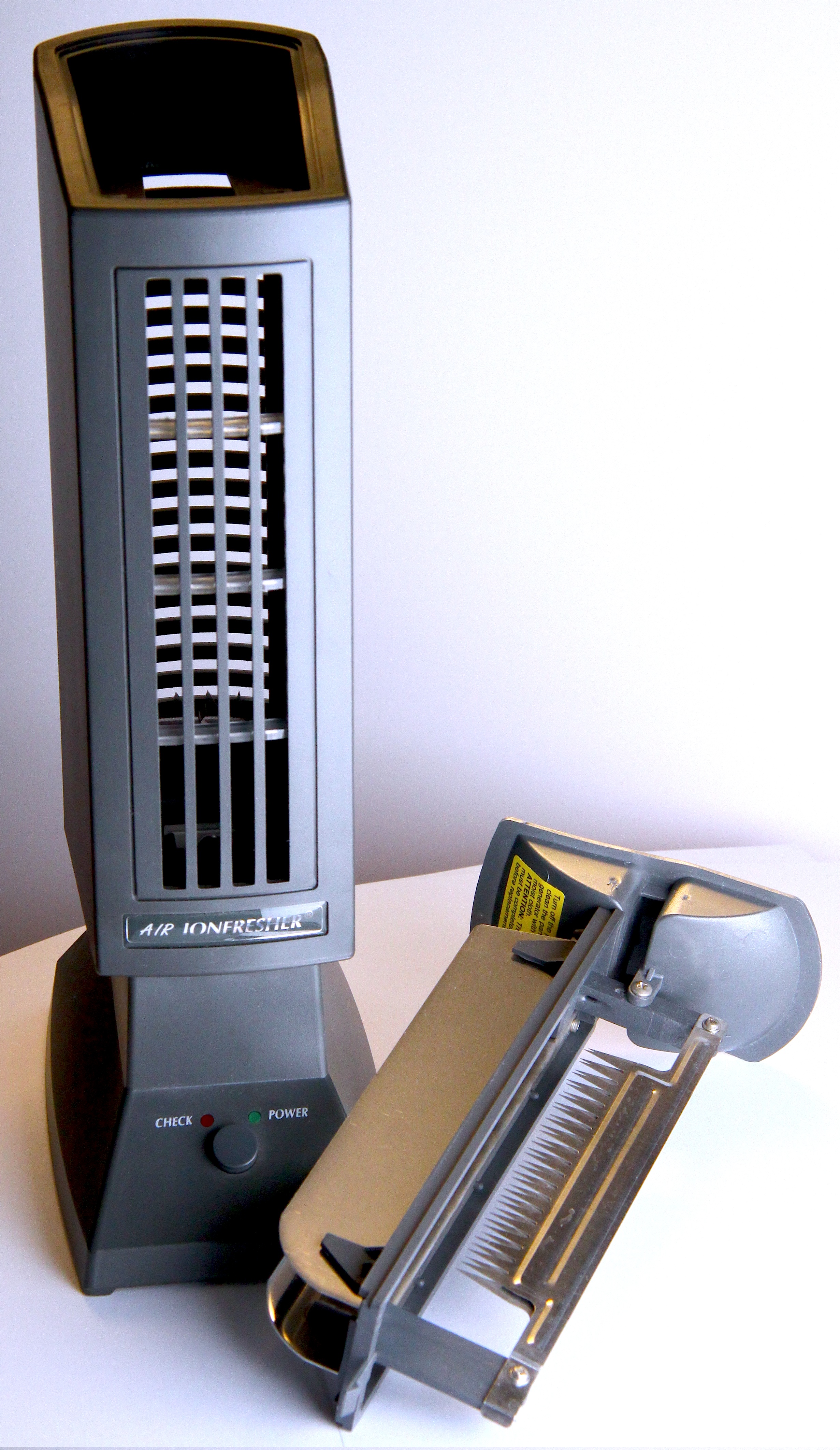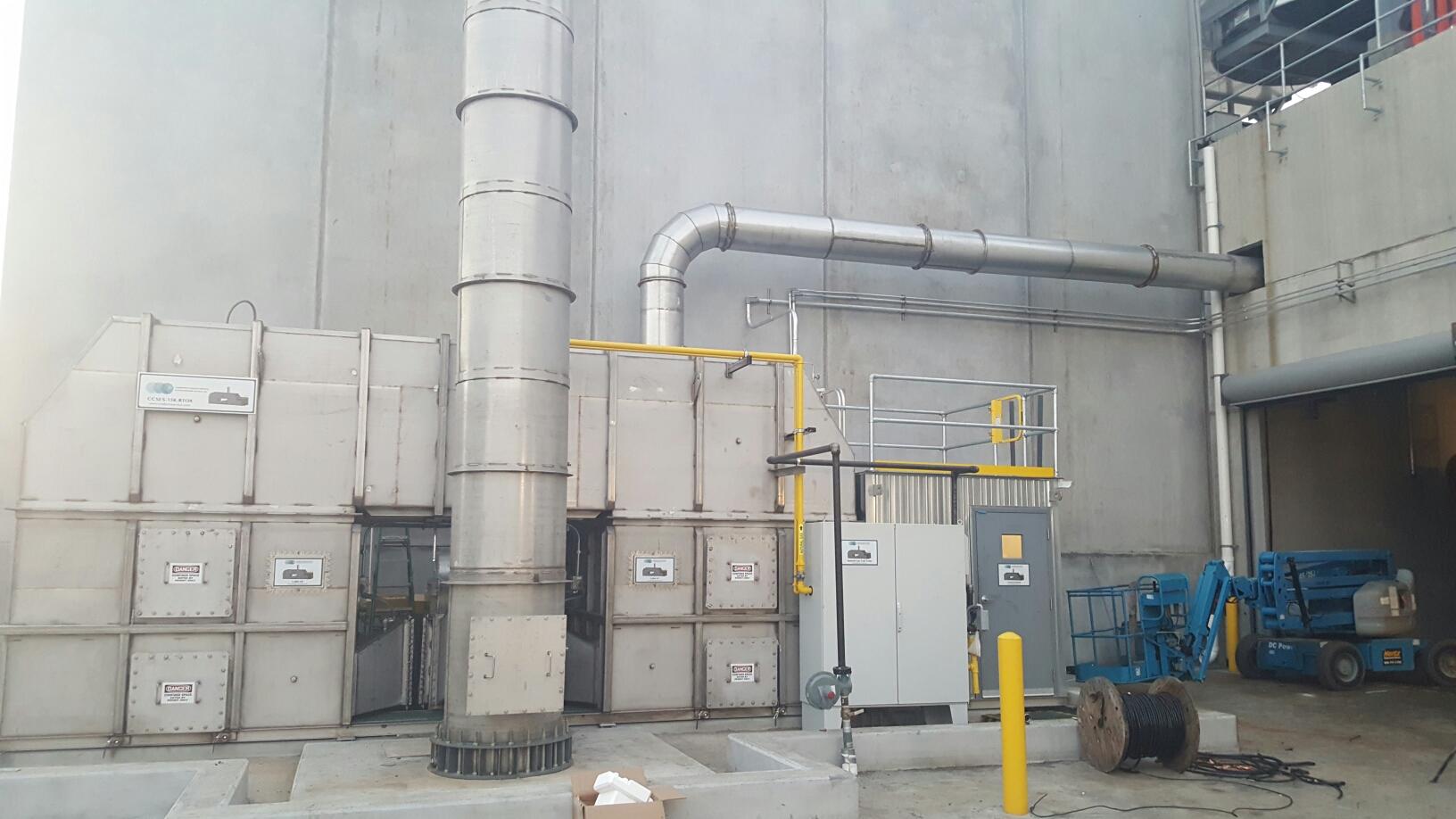|
Air Shower (room)
Air showers are specialized enclosed antechambers which are incorporated as entryways of cleanrooms and other controlled environments to reduce particle contamination. Air showers utilize high-pressure, HEPA- or ULPA- filtered air to remove dust, fibrous lint, and other contaminants from personnel or object surfaces. The forceful "cleansing" of surfaces before entering clean environments reduces the number of airborne particulates introduced. When properly incorporated into cleanroom design, air showers provide an ISO-classified transition vestibule to ensure the cleanliness of the classified cleanroom. Air showers are typically placed between a gowning area and cleanroom; after workers don appropriate garb and personal protective equipment, they enter the shower so that the pressurized air nozzles remove any residual particles from coveralls. Once the program cycle is complete, users exit through a second door into the cleanroom. Air showers (or air tunnels) may also be place ... [...More Info...] [...Related Items...] OR: [Wikipedia] [Google] [Baidu] |
Cleanroom Air Shower
A cleanroom or clean room is an engineered space that maintains a very low concentration of airborne particulates. It is well-isolated, well-controlled from contamination, and actively cleansed. Such rooms are commonly needed for scientific research and in industrial production for all nanoscale processes, such as semiconductor device fabrication, semiconductor device manufacturing. A cleanroom is designed to keep everything from dust to airborne organisms or vaporised particles away from it, and so from whatever material is being handled inside it. A cleanroom can also prevent the escape of materials. This is often the primary aim in hazardous biological engineering, biology, nuclear engineering, nuclear work, pharmaceutical industry, pharmaceutics, and virology. Cleanrooms typically come with a cleanliness level quantified by the number of particles per cubic meter at a predetermined molecule measure. The ambient outdoor air in a typical urban area contains 35,000,000 pa ... [...More Info...] [...Related Items...] OR: [Wikipedia] [Google] [Baidu] |
Protocol (science)
In natural and social science research, a protocol is most commonly a predefined procedural method in the design and implementation of an experiment. Protocols are written whenever it is desirable to standardize a laboratory method to ensure successful replication of results by others in the same laboratory or by other laboratories. Additionally, and by extension, protocols have the advantage of facilitating the assessment of experimental results through peer review. In addition to detailed procedures, equipment, and instruments, protocols will also contain study objectives, reasoning for experimental design, reasoning for chosen sample sizes, safety precautions, and how results were calculated and reported, including statistical analysis and any rules for predefining and documenting excluded data to avoid bias. Similarly, a protocol may refer to the procedural methods of health organizations, commercial laboratories, manufacturing plants, etc. to ensure their activities (e.g., ... [...More Info...] [...Related Items...] OR: [Wikipedia] [Google] [Baidu] |
Tunnel
A tunnel is an underground or undersea passageway. It is dug through surrounding soil, earth or rock, or laid under water, and is usually completely enclosed except for the two portals common at each end, though there may be access and ventilation openings at various points along the length. A pipeline differs significantly from a tunnel, though some recent tunnels have used immersed tube construction techniques rather than traditional tunnel boring methods. A tunnel may be for foot or vehicular road traffic, for rail traffic, or for a canal. The central portions of a rapid transit network are usually in the tunnel. Some tunnels are used as sewers or aqueducts to supply water for consumption or for hydroelectric stations. Utility tunnels are used for routing steam, chilled water, electrical power or telecommunication cables, as well as connecting buildings for convenient passage of people and equipment.Salazar, Waneta. ''Tunnels in Civil Engineering''. Delhi, India : Wh ... [...More Info...] [...Related Items...] OR: [Wikipedia] [Google] [Baidu] |
Kill Switch
A kill switch, also known more formally as an emergency brake, emergency stop (E-stop), emergency off (EMO), or emergency power off (EPO), is a safety mechanism used to shut off machinery in an emergency, when it cannot be shut down in the usual manner. Unlike a normal shut-down switch or shut-down procedure, which shuts down all systems in order and turns off the machine without damage, a kill switch is designed and configured to abort the operation as quickly as possible (even if it damages the equipment) and to be operated simply and quickly (so that even a panicked operator with impaired executive functions or a bystander can activate it). Kill switches are usually designed to be noticeable, even to an untrained operator or a bystander. Some kill switches feature a removable, protective barrier against accidental activation (e.g. a plastic cover that must be lifted or glass that must be broken), known as a mollyguard. Kill switches are features of mechanisms whose normal ... [...More Info...] [...Related Items...] OR: [Wikipedia] [Google] [Baidu] |
Interlock (engineering)
An interlock is a feature that makes the state of two mechanisms or functions mutually dependent. It may consist of any electrical or mechanical devices, or systems. In most applications, an interlock is used to help prevent any damage to the machine or to the operator handling the machine. For example, elevators are equipped with an interlock that prevents the moving elevator from opening its doors and prevents the stationary elevator (with open doors) from moving. Interlocks may include sophisticated elements such as curtains of Infrared beam, infrared beams, photodetectors, simple Switch, switches, and lock and key, locks. It can also be a computer containing an interlocking computer program with digital electronics, digital or analogue electronics, analogue electronics. Trapped-key interlocking Trapped-key interlocking is a method of ensuring safety in industrial environments by forcing the operator through a predetermined sequence using a defined selection of keys, locks and ... [...More Info...] [...Related Items...] OR: [Wikipedia] [Google] [Baidu] |
Electrostatic Discharge
Electrostatic discharge (ESD) is a sudden and momentary flow of electric current between two differently-charged objects when brought close together or when the dielectric between them breaks down, often creating a visible electric spark, spark associated with the static electricity between the objects. ESD can create spectacular electric sparks (lightning, with the accompanying sound of thunder, is an example of a large-scale ESD event), but also less dramatic forms, which may be neither seen nor heard, yet still be large enough to cause damage to sensitive electronic devices. Electric sparks require a field strength above approximately 4 million V/m in air, as notably occurs in lightning strikes. Other forms of ESD include corona discharge from sharp electrodes, brush discharge from blunt electrodes, etc. ESD can cause harmful effects of importance in industry, including explosions in gas, fuel vapor and coal dust, as well as failure of solid state electronics components such as ... [...More Info...] [...Related Items...] OR: [Wikipedia] [Google] [Baidu] |
Measuring Instrument
Instrumentation is a collective term for measuring instruments, used for indicating, measuring, and recording physical quantities. It is also a field of study about the art and science about making measurement instruments, involving the related areas of metrology, automation, and control theory. The term has its origins in the art and science of scientific instrument-making. Instrumentation can refer to devices as simple as direct-reading thermometers, or as complex as multi- sensor components of industrial control systems. Instruments can be found in laboratories, refineries, factories and vehicles, as well as in everyday household use (e.g., smoke detectors and thermostats). Measurement parameters Instrumentation is used to measure many parameters (physical values), including: *Pressure, either differential or static * Flow *Temperature * Levels of liquids, etc. *Moisture or humidity *Density *Viscosity * ionising radiation * Frequency * Current *Voltage * Induct ... [...More Info...] [...Related Items...] OR: [Wikipedia] [Google] [Baidu] |
Electric Charges
Electric charge (symbol ''q'', sometimes ''Q'') is a physical property of matter that causes it to experience a force when placed in an electromagnetic field. Electric charge can be ''positive'' or ''negative''. Like charges repel each other and unlike charges attract each other. An object with no net charge is referred to as electrically neutral. Early knowledge of how charged substances interact is now called classical electrodynamics, and is still accurate for problems that do not require consideration of quantum effects. In an isolated system, the total charge stays the same - the amount of positive charge minus the amount of negative charge does not change over time. Electric charge is carried by subatomic particles. In ordinary matter, negative charge is carried by electrons, and positive charge is carried by the protons in the nuclei of atoms. If there are more electrons than protons in a piece of matter, it will have a negative charge, if there are fewer it will have a p ... [...More Info...] [...Related Items...] OR: [Wikipedia] [Google] [Baidu] |
Static Electricity
Static electricity is an imbalance of electric charges within or on the surface of a material. The charge remains until it can move away by an electric current or electrical discharge. The word "static" is used to differentiate it from electric current, current electricity, where an electric charge flows through an electrical conductor. A static electric charge can be created whenever two surfaces contact and/or slide against each other and then separate. The effects of static electricity are familiar to most people because they can feel, hear, and even see sparks if the excess charge is neutralized when brought close to an electrical conductor (for example, a path to ground), or a region with an excess charge of the opposite polarity (positive or negative). The familiar phenomenon of a static shockmore specifically, an electrostatic dischargeis caused by the neutralization of a charge. Causes Materials are made of atoms that are normally electrically neutral because they contai ... [...More Info...] [...Related Items...] OR: [Wikipedia] [Google] [Baidu] |
Air Ionizer
An air ioniser (or negative ion generator or Chizhevsky's chandelier) is a device that uses high voltage to ionise (electrically charge) air molecules. Negative ions, or anions, are particles with one or more extra electrons, conferring a net negative charge to the particle. Cations are positive ions missing one or more electrons, resulting in a net positive charge. Some commercial air purifiers are designed to generate negative ions. Another type of air ioniser is the electrostatic discharge (ESD) ioniser (balanced ion generator) used to neutralise static charge. History In 1918 Alexander Chizhevsky created the first air ioniser for ion therapy. It was originally used for animal health in agriculture. This discovery ignited Cecil Alfred "Coppy" Laws' interest in the phenomenon of air ionisation. Laws has been credited with being the inventor of the domestic air ioniser. Ionic air purifiers Air ionisers are used in air purifiers to remove particles from air. Airborne parti ... [...More Info...] [...Related Items...] OR: [Wikipedia] [Google] [Baidu] |
Duct (flow)
Ducts are conduits or passages used in heating, ventilation, and air conditioning (HVAC) to deliver and remove air. The needed airflows include, for example, ''supply air'', ''return air'', and ''exhaust air''. Ducts commonly also deliver '' ventilation air'' as part of the supply air. As such, air ducts are one method of ensuring acceptable indoor air quality as well as thermal comfort. A duct system is also called ''ductwork''. Planning (laying out), sizing, optimizing, detailing, and finding the pressure losses through a duct system is called ''duct design''. Materials Ducts can be made out of the following materials: They are Galvanized steel Galvanized mild steel is the standard and most common material used in fabricating ductwork because the zinc coating of this metal prevents rusting and avoids cost of painting. For insulation purposes, metal ducts are typically lined with faced fiberglass blankets (duct liner) or wrapped externally with fiberglass blankets (duct wr ... [...More Info...] [...Related Items...] OR: [Wikipedia] [Google] [Baidu] |
Plenum Chamber
A plenum chamber is a pressurised housing containing a fluid (typically air) at positive pressure. One of its functions is to equalise pressure for more even distribution, compensating for irregular supply or demand. It is typically relatively large in volume and thus has relatively low velocity compared to the system's other components. In wind tunnels, rockets, and many flow applications, it is a chamber upstream on the fluid flow where the fluid initially resides (approximately at rest). It can also work as an acoustic silencer. Examples Examples of plenum chambers include those used with: * Superchargers * Hovercraft * Corliss steam engines * Raised floors and false ceilings in equipment rooms * Some organ (music), organs (to supplement the bellows) * A number of aerophones, such as the bag of bagpipes and the ''slow air chamber'' of the Native American flute * Anaesthetic vaporiser#Plenum vaporisers, Plenum chamber anesthetic vaporizers * Rocket engine#Combustion chamber, R ... [...More Info...] [...Related Items...] OR: [Wikipedia] [Google] [Baidu] |








